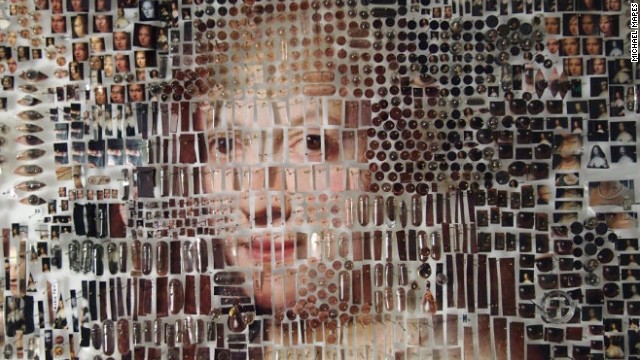.cnn_html_media_utility::before{color:red;content:’>>’;font-size:9px;line-height:12px;padding-right:1px}
.cnnstrylccimg640{margin:0 27px 14px 0}
.captionText{filter:alpha(opacity=100);opacity:1}
.cnn_html_slideshow_media_caption a,.cnn_html_slideshow_media_caption a:visited,.cnn_html_slideshow_media_caption a:link,.captionText a,.captionText a:visited,.captiontext a:link{color:outline:medium none}
.cnnVerticalGalleryPhoto{margin:0 auto;padding-right:68px;width:270px}
]]>
 Michael Mapes recreated some of a Dutch Masters’ many famous portraits.
Michael Mapes recreated some of a Dutch Masters’ many famous portraits.

Instead of regulating paint, Mapes uses photographs, sequins, insect pins, vials and some-more to square together Bartholomeus outpost der Helst’s 1668 mural of Geertruida basement Dubbelde.
 He calls these equipment “biographical DNA.”
He calls these equipment “biographical DNA.”
 Mapes considers any theme as a collection of particular parts.
Mapes considers any theme as a collection of particular parts.
 Each particular citation is pinned to foam.
Each particular citation is pinned to foam.
 These multi-medium collages demeanour like a work of an spooky investigator piecing together a mystery.
These multi-medium collages demeanour like a work of an spooky investigator piecing together a mystery.
 Mapes began these mural array by regulating subjects he indeed knows.
Mapes began these mural array by regulating subjects he indeed knows.
 This done it easier to accumulate his biological DNA.
This done it easier to accumulate his biological DNA.
 In a way, these particular tools assistance to qualification a richer account about a subjects of these portraits.
In a way, these particular tools assistance to qualification a richer account about a subjects of these portraits.
 Mapes considers his reworked portraits as an artistic reexamination.
Mapes considers his reworked portraits as an artistic reexamination.

1

2

3

4

5

6

7

8

9

10
(Wired) — It’s fun to suppose what Michael Mapes’ studio contingency demeanour like: You would assume that a New York-based artist’s workspace has to resemble a lab of a harebrained entomologist, with exam tubes, citation bags and pushpins strewn about.
In reality, of course, to emanate a startlingly elaborate sculptural portraits Mapes is famous for, he has to be many some-more orderly than that. “It does take a sincerely high grade of organization,” assures me. “But that’s not a hardest part.”
Take a peek by Mapes’ work, and you’ll know what he means. Technically, Mapes is a portraitist, yet he frequency uses paint. Instead, a artist recreates a tellurian physiognomy by arranging fragments of a person’s life—photographs, thatch of hair, scratch samples, jewelry—into rarely minute works of art.
Read more: 7 Hand Gestures That Make You Look Like a Real Intellectual
Mapes has been creation these pieces for years, generally operative with subjects closely tighten to him. But in his newest project, he’s motionless to deconstruct (then reconstruct) some of a Dutch Masters’ many famous 17th century portraits, digest classics like Bartholomeus outpost der Helst’s portrayal of Geertruida basement Dubbelde into extraordinary franken-portraits.
Each of Mapes’ pieces are assembled from what he describes as “biographical DNA,” a small pieces of earthy information he pieces together to emanate a finished portrait. Typically, this is a sincerely elementary routine with Mapes entertainment his photos, pieces of hair, and scratch samples from his vital subject’s home and afterwards organizing them into a mural regulating exam tubes, small baggies or pushpins. With a Dutch Masters series, he had to be a bit some-more resourceful.
Mapes starts any mural by downloading copyright-free images from several museums’ websites. From there, he crops any image, zeroing in on certain facilities like an eyeball, fingertip or face before copy out dozens of each. “I’m spasmodic reminded that I’m not a standard patron when a manager walks a pouch of prints out to me privately with a extraordinary eye,” he says.
Read more: Ever Seen These Pics of MDMA and LSD? Dude, They’re Intense
He considers any theme as a collection of particular parts. “I tend to furnish hundreds and hundreds of samples before we start operative with a tangible composition,” he explains. “In this way, we can work some-more intuitively in a composition, again, with a suggestion of a painter—in a lab coat, so to speak.” The routine of entertainment these pieces of biographical DNA is an try to form some arrange of cohesive design about what a final mural should demeanour like. “I generally fasten a series of photos on a wall and contemplate where to go from there,” he says.
Of course, Mapes’ final mural is going to demeanour a lot like a original, usually with a many some-more of an artistically rendered tabernacle vibe. There are crafty and nuanced departures from a 17th-century versions. For example, one thing we notice about a Dutch Masters’ portraits is how definitely PG they are. Women are hidden in black, their necks even entirely covered. “These subjects were certainly good famous to a artists who embellished them,” says Mapes. “Imagine a patience compulsory of outpost der Helst in not including a bit of Geertruida’s legs.”
Read more: Did a Nazis also take a Mona Lisa?
At a distance, Mapes’ work echoes a righteous acerbity of a Dutch Masters, though when we get adult tighten and unequivocally inspect what his sculptural paintings are done of you’ll notice photographs of unclothed legs and pieces of disruption stuffing out a skin tinge of a Dutch Masters’ subjects. Mapes has even incorporated thatch of hair.
All this is an try to change the perspectives, and hopefully enthuse us to re-examine how we understand what’s around us. “My hope,” he says. “Is that it encourages opposite ways of estimate and interpreting what and how we demeanour during things—art, scholarship or anything.”
Read some-more from WIRED:
Could a Mix of Sand and Pee Be a Super-Green Replacement for Concrete?
Watch: This High-Tech 3-D Cardboard Could Make Bubble Wrap Obsolete
A Genius Design for Airplane Seats as Comfy as Aeron Chairs
Subscribe to WIRED repository for reduction than $1 an emanate and get a FREE GIFT! Click here!
Copyright 2011 Wired.com.
